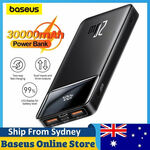Stacking both Baseus 20% off Code (CHARGER20) + eBay Code (TOPH20, TOPH22) for a Total of 36% off (37.6% off with eBay Plus)
10000mah 15W - $19.19 ($18.71 eBay Plus)
20000mah 15W - $23.03 ($22.46 eBay Plus)
30000mah 15W - $28.15 ($27.45 eBay Plus)
10000mah 20W - $23.03 ($22.46 eBay Plus)
20000mah 20W - $29.43 ($28.70 eBay Plus)
30000mah 20W - $38.39 ($37.43 eBay Plus)
Note: the 30000mah (111Wh) Power Banks may require airline approval when travelling






are the magsafe iphone chargers included in this?